Martin Professional Introduces New DMX Splitters
Martin Professional offers two new economical DMX splitters for proper data transmission and protection of DMX controllers and devices. The DMX 5.3 Splitter and RDM 5.5 Splitter are useful in maintaining proper data over long runs or several runs of DMX signal with the RDM 5.5 Splitter also capable of handling RDM data.
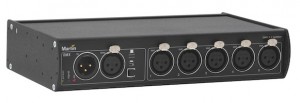 The Martin Splitters help to rectify disruptions in the DMX signal caused by bad cables or bad connections by splitting the DMX or DMX/RDM data link into five separate branches while boosting the weak DMX signal to its original output level before it becomes too low to be read by DMX devices.
The Martin Splitters help to rectify disruptions in the DMX signal caused by bad cables or bad connections by splitting the DMX or DMX/RDM data link into five separate branches while boosting the weak DMX signal to its original output level before it becomes too low to be read by DMX devices.
Through fully individual isolated input and 5 outputs, the Martin Splitters will protect any DMX controller and DMX fixture against voltage surge on the data line. Ground loops are common in complex lighting setups and such problems can create errors in the DMX data. The Martin Splitters will help to prevent such situations.
Another common issue with DMX communication is reflection caused by long lines, too many connections, or too many devices on the same line, etc. The Martin Splitters prevent such reflection by dividing the load over several outputs, therefore making shorter lines with less connections and devices. If an error is detected on the DMX line, the Splitter will illuminate an error LED.
A lightweight yet robust construction makes these handy devices optimal tools for the often harsh touring environment. Both Splitters are easily rack, truss or wall mountable and rigging is easy using a standard G-Clamp. A universal power supply guarantees worldwide usage.
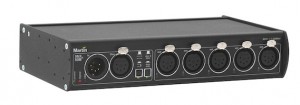 Martin RDM 5.5 Splitter
Martin RDM 5.5 Splitter
The Martin RDM 5.5 Splitter is the perfect companion to any controller or DMX/RDM device by also allowing for transmission of RDM data either way on the DMX line (most DMX splitters will not allow such data traffic to be processed). A built-in microprocessor manages the RDM information efficiently by avoiding data collisions and reducing discovery time of RDM devices on the link. In and Out PowerCon connectors make for easy daisy-chaining.
Review: The TRX Series, from City Theatrical and Philips Color Kinetics
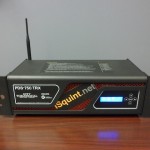 Not long ago, Philips Color Kinetics introduced the next generation of Color Blast’s: The TRX Series. Adding 2 new colors to the standard regimen of Red, Green, and Blue, these new Color Blasts called for a more intelligent power supply. Providing this new backbone is City Theatrical and the new PDS-750 TRX Power and Data Supply. Not one to rest on their laurels, City Theatrical raised the bar with this reinvention of their industry standard PDS. Lets start at the beginning:
Not long ago, Philips Color Kinetics introduced the next generation of Color Blast’s: The TRX Series. Adding 2 new colors to the standard regimen of Red, Green, and Blue, these new Color Blasts called for a more intelligent power supply. Providing this new backbone is City Theatrical and the new PDS-750 TRX Power and Data Supply. Not one to rest on their laurels, City Theatrical raised the bar with this reinvention of their industry standard PDS. Lets start at the beginning:
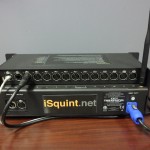 The PDS 750 TRX is housed in a very sturdy, 3U rack mount or pipe mount housing. The front panel has the factory label; a stylish, red air flow grill; and the back-lit LED display and 5 button control interface. On the top of the fixture is a welcome cheat sheet that covers basic setup in all modes. The back panel contains the PowerCon power input and fuse, the 5-Pin DMX In and Out, a USB connection for software updates, a 2-port EtherCon switch, the 12 4-Pin Fixture outputs, and the SHoW DMX wireless antenna. There is also a small hole in the metal casing, presumably for a safety cable if you are pipe mounting the PDS.
The PDS 750 TRX is housed in a very sturdy, 3U rack mount or pipe mount housing. The front panel has the factory label; a stylish, red air flow grill; and the back-lit LED display and 5 button control interface. On the top of the fixture is a welcome cheat sheet that covers basic setup in all modes. The back panel contains the PowerCon power input and fuse, the 5-Pin DMX In and Out, a USB connection for software updates, a 2-port EtherCon switch, the 12 4-Pin Fixture outputs, and the SHoW DMX wireless antenna. There is also a small hole in the metal casing, presumably for a safety cable if you are pipe mounting the PDS.
Control of PDS-750 TRX is available via wired DMX, wireless SHoW DMX, Ethernet (ArtNet, sACN, or Ki-Net) or using one of the on-board programs or static colors. Setup is quick and simple. Plug in your power cord and hook up your fixtures and then using either the on-board setup wizard or the advanced setup menus you can select your method of control. The PDS-750 TRX will run any combination of 2, 3 or 5 color CK fixtures. Using the on-board fixture patch you can actively adapt the fixture’s address’s so that there are no wasted DMX channels as in the past. A nice part about the setup wizard is that it will also identify the types of fixtures connected and ask you what control profile you want to use.
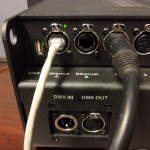 DMX control of the PDS-750 TRX is as simple as connecting a control source to the 5-pin input on the unit. In basic 8-bit mode, the fixtures operate on one channel per color, up to the full 5 colors available in the Color Blast TRX’s. Using my test console (an Elation SDC-6), the Color Blast dimmed smoothly and with a very even curve.
DMX control of the PDS-750 TRX is as simple as connecting a control source to the 5-pin input on the unit. In basic 8-bit mode, the fixtures operate on one channel per color, up to the full 5 colors available in the Color Blast TRX’s. Using my test console (an Elation SDC-6), the Color Blast dimmed smoothly and with a very even curve.
SHoW DMX control allows the PDS to operate wirelessly on any one of 16 different channels (or universes). Using the same test console connected to a standard SHoW DMX indoor transmitter, I had full control of the fixture with zero lag time despite four WiFi networks and Bluetooth scanners also running in the same environment. A feature of note when running SHoW DMX is that the DMX connector on the back of the PDS will output whatever universe the PDS is receiving. This allows you to control the rest of your DMX devices without investing in more receivers. It’s a very nice hat-tip from the folks at CTI.
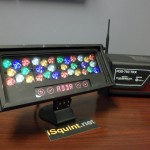 Ethernet control of the PDS was a bit more challenging, but only due to the steps needed to enter the IP address information. You can control the PDS over ArtNet, sACN (think ETCNet 3), or Ki-Net (Color Kinetics Architectural). Having the extra Ethernet port is an excellent add-on that makes daisy chaining multiple PDS units a snap.
Ethernet control of the PDS was a bit more challenging, but only due to the steps needed to enter the IP address information. You can control the PDS over ArtNet, sACN (think ETCNet 3), or Ki-Net (Color Kinetics Architectural). Having the extra Ethernet port is an excellent add-on that makes daisy chaining multiple PDS units a snap.
Not having a sACN source, I setup and configured the PDS for ArtNet control on a static IP address. I then logged into the WiFi network with my iPad and using Alcorn McBride’s LightingPad was able to control the PDS perfectly. There was no lag time and the dimming curves were as smooth as ever. CTI also gives Ethernet control the same hat-tip as SHoW DMX by outputting the same control universe to the DMX port on back.
Not to be outdone, Philips Color Kinetics has taken the next generation Color Blast TRX to the next level. Featuring not just RGB color mixing, CK added Amber and White to the mix. For theatre and Broadway applications, the soft tones that can now be mixed are a most welcome addition. The Color Blast TRX also features a first-ever 4-character LED display and touch sensitive buttons for at-fixture controls. As introduced with the TR, the TRX features both clear and frosted lenses that can be swapped out. The rubber surround is gone and in its place is a CTI accessory holder.
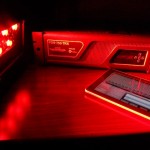 Operation of the on-board control is simple and elegant. Press the two outermost buttons at the same time and the controls unlock for about 60 seconds. You can set the DMX address, fixture profile, set static colors, chases, and run a test mode to name a few functions. The control buttons use the same type of touch sensor glass that many smart phones use. You don’t actually press them, you just tap them. One would imagine this will significantly increase fixture reliability as adding physical contactors adds a mechanical failure point.
Operation of the on-board control is simple and elegant. Press the two outermost buttons at the same time and the controls unlock for about 60 seconds. You can set the DMX address, fixture profile, set static colors, chases, and run a test mode to name a few functions. The control buttons use the same type of touch sensor glass that many smart phones use. You don’t actually press them, you just tap them. One would imagine this will significantly increase fixture reliability as adding physical contactors adds a mechanical failure point.
Overall the color mix and output of the new Color Blast TRX is excellent. However, don’t get rid of your iW Blasts just yet. The amber and white are excellent additions that allow the TRX to mix some amazing new colors. However, the white and amber only output is just not quite bright enough to be effective on its own. Overall though, Philips Color Kinetics has added an excellent new addition to the Color Blast legacy. Combined with City Theatrical’s new PDS-750 TRX, the bar has been set for ease of use and functionality.
 The new TRX technology is available now for purchase and rental from most of your top lighting dealers in the US. To round out the family, CTI also introduced the new PDS-350 TRX (6-channel vs. 12-channel). For more information please visit either City Theatrical or Color Kinetic’s websites.
The new TRX technology is available now for purchase and rental from most of your top lighting dealers in the US. To round out the family, CTI also introduced the new PDS-350 TRX (6-channel vs. 12-channel). For more information please visit either City Theatrical or Color Kinetic’s websites.
LSC Lighting Announces NEXUS Ethernet/DMX Converters

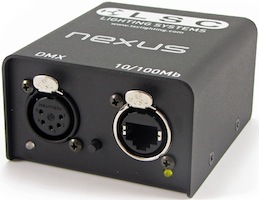 The NEXUS range is the latest addition to LSC’s Data Distribution products and offers conversion between DMX512 signals and Ethernet and currently supports both the Art-Net and Streaming ACN (SACN) protocols.
The NEXUS range is the latest addition to LSC’s Data Distribution products and offers conversion between DMX512 signals and Ethernet and currently supports both the Art-Net and Streaming ACN (SACN) protocols.
NEXUS provides the ability to convert between the two most popular Ethernet protocols namely Art-Net and Streaming ACN (SACN) and DMX512. Going further than your average converter, NEXUS allows users to:
- merge two universes onto a single port on an LTP or HTP basis by universe or by slot (channel)
- Soft patch across multiple universes
- Auto switch between two assigned universes for redundancy purposes
- Merge two universes and resend these as new Art-Net or SACN stream
Three models are available namely a single port portable Ethernet / DMX converter, a 5-port rack-mount Ethernet / DMX512 converter and a 5-port truss-mount Ethernet / DMX512 converter. Powercon power input connectors are available as an option on the 5-port units. The single port unit is powered via Power over Ethernet (PoE).
The units are supplied with female DMX512 connectors as conversion from Art-Net / SACN to DMX512 is the most common use for these units. However with the appropriate sex-change connectors, any unit can be configured for DMX512 to Art-Net/SACN conversion. In fact in the 5-port versions it is possible to configure a mixture of DMX512 ports; some as inputs and some as outputs making the system extremely flexible.
Complimentary to the NEXUS range of products is NexLan software. With versions available to run on Windows, Mac and other platforms, NexLan software is free and used to configure and monitor the NEXUS range of products.
You can find more information on the new NEXUS range at LSC’s website www.lsclighting.com.
LumenRadio Available in North America AGAIN Through TMB

TMB and LumenRadio announced today the immediate availability across North America of the entire range of CRMX wireless lighting control products.
LumenRadio’s proprietary CRMX products are available in a variety of form factors and feature levels to meet the requirements of the entertainment and architectural lighting markets alike. All products provide Lumen’s proprietary automated cognitive coexistence; error correction; synchronization; encryption; deterministic latency of 5ms; and outstanding range and reliability. Protocol support includes DMX, RDM, DALI, Art-Net, sACN, ETCNet2, ETC Net3, Strand ShowNet, and Pathport. Two consecutive PLASA Awards for Innovation and accolades from industry experts and the industry at large, as well as a very impressive reference list of high profile installations and events, have firmly established LumenRadio as the undisputed wireless technology leader.
See the full range of LumenRadio products at USITT 2011. TMB is exclusive distributor for LumenRadio in North America and the UK. For more information about LumenRadio and CRMX wireless lighting controls please visit www.tmb.com/lumenradio or www.lumenradio.com.
#LDI2010 – Enttec Datagate Mk2
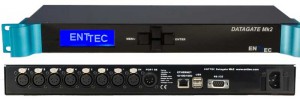 Datagate Mk2 is a pretty sweet bit of hardware. It allows you take ANYTHING in and spit ANYTHING out.
Datagate Mk2 is a pretty sweet bit of hardware. It allows you take ANYTHING in and spit ANYTHING out.
On the front of the box is a pretty simple panel for making adjustments to the unit like setting an IP address or choosing a profile. The screen can display the status of the unit. The back has 1 DMX in, 8 DMX outs, a gigabit ethernet connection, 2 USB ports and a RS-232 jack.
You make your advanced changes by logging into each units built in web server. From there you set changes to it and your system through a pretty easy to use drag and drop GUI. You virtually patch different elements together to build your show, adjusting settings as you go along.
The built in features are basic DMX splitting, shifting, and generation. Optional upgrades allow you more flexibility like HTP or LTP merges, RDM gateway, and using multiple units as a hot backup so if one unit goes down, your show doesn’t.
The base model starts at $1750 and upgrade licenses range from $150 to $1150.
You can check out more on the Enttec website.
#LDI2010 – Goddard Design RDM-Net
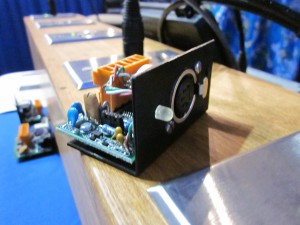 Goddard Design Co. has come up with a solution for distributing RDM beyond a single node. They call it RDM-Net. It’s a tiny little thing that can fit in the palm of my hand, but it allows RDM (by extension of DMX, of course) input anywhere in the path of a data line without the headache of bad data or data reflections. No worries or RF interference.
Goddard Design Co. has come up with a solution for distributing RDM beyond a single node. They call it RDM-Net. It’s a tiny little thing that can fit in the palm of my hand, but it allows RDM (by extension of DMX, of course) input anywhere in the path of a data line without the headache of bad data or data reflections. No worries or RF interference.
If any node in the network sees input it automatically locks out input from any of the other nodes so you don’t have to worry about accidental multiple inputs or anyone purposely trying to mess with you.
The units are bidirectional, so you can use a gender changer to quickly change a unit from input to output or vice versa. The LED on the unit lets you know what state the unit is in so there is no confusion is data is being sent somewhere else on the network. The unit is built using 5-pin Neutrik connectors.
The input module retails for $195, and the output for $198. A standard metal wall plate goes for $12.
You can find more information on their website at www.goddarddesign.com.
Welcome Contributing Writer – Eric Boxer
 I’m not gonna lie, this is pretty sweet. Not only do I get to go to the coolest trade show in the world (I mean, it’s the trade show that showcases everything that other trade shows use to showcase and highlight their stuff), but I get to help those who can’t make it experience it. It’s a lot of show floor and I look forward to working with Justin and all the other contributors to cover every inch of it. I’ll be focusing on data distribution and infrastructure as well as some hands on time with as many consoles as I can.
I’m not gonna lie, this is pretty sweet. Not only do I get to go to the coolest trade show in the world (I mean, it’s the trade show that showcases everything that other trade shows use to showcase and highlight their stuff), but I get to help those who can’t make it experience it. It’s a lot of show floor and I look forward to working with Justin and all the other contributors to cover every inch of it. I’ll be focusing on data distribution and infrastructure as well as some hands on time with as many consoles as I can.
The show this year is in Vegas, and to be honest I’ve never been. I’m looking forward to seeing what else is around, maybe talk my way backstage to a couple of shows.
Back in Orlando I’m a freelance lighting designer, programmer, and draftsman. Between gigs you’ll either find me bouldering at the local climbing gym (Florida is pretty flat people) or at the dog park with my dachshund, Oscar. I’ve also been known to frequent the local Apple store. A lot.
Oh, I also insist on taking pictures. With everyone.
Don’t be shy, If you see me come say hey. I look forward to meeting all of you!
Martin Announces New USB DMX Dongle, USB Duo DMX
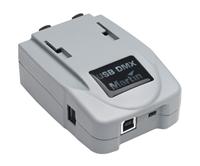 When ever Martin Announces or releases a new product, it seems like it comes in pairs or a whole bunch at once. Following the announcement of the Martin One-Key, Martin Professional announces a new USB DMX device called Martin USB DUO DMX.
When ever Martin Announces or releases a new product, it seems like it comes in pairs or a whole bunch at once. Following the announcement of the Martin One-Key, Martin Professional announces a new USB DMX device called Martin USB DUO DMX.
This new USB device carries two XLR 5 pins and the latest DMX implementation with RDM capability. Each Martin USB DUO DMX can be used to give two additional DMX outputs/inputs to the following software: LightJockey II, M-PC Basic, M-PC Pro, MSD5, MaxModules, Martin M1 and Maxedia. Drivers for the Martin USB DUO DMX are available for Windows XP, Vista, and 32- or 64-bit Windows 7.
No information about pricing or availability has been made public yet, but as PLASA 2010 is right around the corner, there is a good chance you can see all of Martin’s new offerings at their stand in Earls Court.
Martin Announces Martin One-Key
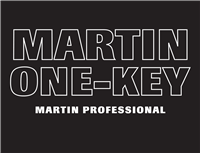 Martin One-Key is a future-proof concept to distribute software licenses without the inconvenience of storing licenses in DMX hardware as we’ve been used to for the last 20 years. From now on, all Martin Professional PC-based applications will share the same protection method.
Martin One-Key is a future-proof concept to distribute software licenses without the inconvenience of storing licenses in DMX hardware as we’ve been used to for the last 20 years. From now on, all Martin Professional PC-based applications will share the same protection method.
Martin One-Key is a simple USB dongle that can store one or multiple licenses and protects the software from illegal copies, therefore protecting the user’s investment. No longer will software licenses be unlocked by DMX hardware that usually becomes obsolete after a few years, or even worse becomes defective and renders the software unusable.
Once a user owns the Martin One-Key, adding new software is a few click process; no need to wait for a box to be delivered. With Martin One-Key, users can easily try any other Martin Professional software for a 45-day trial period with all features. Martin One-Key simplifies software distribution, improves protection, protects investments, and opens doors to new ideas never tried before. Martin One-Key is the future, now.
Martin One-Key is now bundled with the following products:
- LightJockey II Kit
- M-PC-Basic 8 universes Kit
- M-PC Pro 64 Universes Kit
- MSD5 Gold
- MSD5 Live
- MSD5 Live-4
- Martin M1 (built-in key)
- All MaxModules (built-in key)
- Maxxyz Compact (built-in key) Note: Martin M1, all MaxModules and Maxxyz Compact already use an internal Martin One-Key since their introduction.
To learn more about the Martin One-Key, visit their website at www.martin.com.
E:Cue Introduces Video Micro Converter, (VMC)
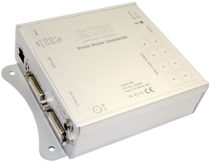 E:cue Lighting recently announced the release of a new product, the VMC or Video Micro Converter. The Video Micro Converter (VMC) is a compact device used to convert a DVI signal to DMX or e:pix*, for LED control of large media screens. Specially designed to easily output video content on LED media installations, one VMC grabs video signals of up to 4096 pixels. For video lighting installations requiring more than 4096 pixels, multiple VMCs can be daisy chained to convert the entire DVI signal to DMX or e:pix.
E:cue Lighting recently announced the release of a new product, the VMC or Video Micro Converter. The Video Micro Converter (VMC) is a compact device used to convert a DVI signal to DMX or e:pix*, for LED control of large media screens. Specially designed to easily output video content on LED media installations, one VMC grabs video signals of up to 4096 pixels. For video lighting installations requiring more than 4096 pixels, multiple VMCs can be daisy chained to convert the entire DVI signal to DMX or e:pix.
The VMC features very flexible pixel mapping capabilities for demanding LED installations ranging from a few hundred, to one million pixels. There are two available versions of this device; VMC outputs DMX and e:pix, while the VMC DMX outputs only DMX.
Some of the Key Features of the VMC
- Highly Versatile Pixel Mapping Capabilities
- Grabs and Converts up to 4096 DVI pixels per VMC
- Internal Active DVI Signal Booster
- Stored Default Image
- Arrange Lighting Fixture and setup VMC’s using the e:cue Software Suite
To learn more about the VMC from e:cue, visit their web site at www.ecue.com.
Goddard Design Announces New DMX Tester – MiniDMXter4
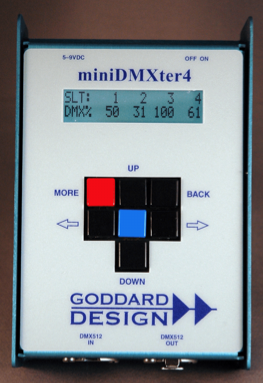 Goddard Design, the makers of the industry popular DMX testing device, the DMXter, has just announced a new DMX testing device, the MiniDMXter4. Very similar to the old Lil’DMXter, the MiniDMXter4 fits in the palm of your hand and has additional features not found in the Lil’DMXter such as RDM management functions.
Goddard Design, the makers of the industry popular DMX testing device, the DMXter, has just announced a new DMX testing device, the MiniDMXter4. Very similar to the old Lil’DMXter, the MiniDMXter4 fits in the palm of your hand and has additional features not found in the Lil’DMXter such as RDM management functions.
More from the Goddard Design Press Release:
The MiniDMXter4 is small – 3-3/4″x6″x1-3/4″. It’s very easy to use. The 7 button interface provides improved menu navigation and the 40 character backlit display provides clear, plain language prompts. The MiniDMXter4’s receive input is properly terminated at all times. The user may turn on the transmitter during reception to allow for loop thru mode (excluding pins 4 and 5). Both input and output support DMX512-A and RDM topologies. The unit is powered by 2 “AA” batteries, a battery eliminator or the USB connector.
The MiniDMXter4 provides 5 transmit modes – ADJUST ONE SLOT, ADJUST ALL SLOTS, AUTOFADE, SEND/EDIT SNAPSHOT, and SEND TEXT. The unit supports 7 transmit flavors, including Colortran.
The MiniDMXter4 displays received levels in numeric or graphic format. The new, larger display allows for 4 slot levels to be shown numerically, or 32 slot levels to be shown graphically. DMX512 text reception is also supported.
Recognizing the need for a handheld tester that handles basic RDM, we’ve included RDM responder address settings and basic configuration routines in the MiniDMXter4.
- Discover all of the new devices on a RDM system
- Select a current device
- Address a current device, set a device label, capture and activate device presets
- Provide information on an RDM device, including device model, device label, manufacturer’s label, software version, current address and DMX footprint, personality, view sensor details, product category, supported PIDs and more.
To learn more about the Goddard Design MiniDMXter4, or to locate a Goddard Design Dealer near you, visit their web site at www.goddarddesign.com.
The New Step for iPhone Lighting Apps
 Yesterday I mentioned yet another lighting iPhone app being released to the market. It just adds to the growing list of lighting iPhone apps already out there. There are quite a few… less expensive iPhone apps that seem to do the exact same thing, just in a different way or with a different look. I do not want to say that any of the iPhone apps that are out there are worthless or useless. In fact they all are quite useful in their own way. That is why I have bought or received codes for almost all of the lighting iPhone apps in the iTunes app store.
Yesterday I mentioned yet another lighting iPhone app being released to the market. It just adds to the growing list of lighting iPhone apps already out there. There are quite a few… less expensive iPhone apps that seem to do the exact same thing, just in a different way or with a different look. I do not want to say that any of the iPhone apps that are out there are worthless or useless. In fact they all are quite useful in their own way. That is why I have bought or received codes for almost all of the lighting iPhone apps in the iTunes app store.
I feel that the lighting iPhone app market is becoming saturated with these one trick ponies. Then there are all of the “remote” apps for major lighting consoles. I believe that those are quite useful if you own or operate that console. But where do we go from here in the lighting iPhone app world? When will there be a revolutionary lighting app that will be different from the rest?
One app developer I think is on the right track. While I can not mention to much about the app as it is still in development and not ready for release, I can leave you with some hints. Think about this, how could you add features and functions to the iPhone, like say check if a DMX cable is wire correctly? Also, think about this, how do manufacturers tend to make additional sales off the original product?
Something is in the works with lighting iPhone apps for us ladies and gentlemen, and from what little I have heard about it, it is going to be pretty sweet! Stay tuned, you won’t want to miss this!
Side note: The first one to tweet this exact phrase wins a special prize, “@isquint, I dig Scooby Snacks!”.
LatestHeadlines
- Upgrading Your Toolbox: City Theatrical DMXcat-E and DMXcat Multi Function Test Tool
- Claypaky Bringing Back the Sexy to Par Cans with the Midi-B FX
- Ayrton Evolves the Cobra, the Cobra2 Developed for the US Market
- MA Lighting Intros grandMA3 onPC Fader Wing and DIN-Rail Nodes
- Live Events LEVL Up Fest: A Festival to Aid our Industry